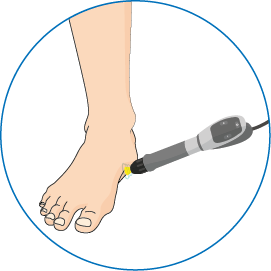This leaflet provides information for patients considering shockwave therapy as part of their treatment. It provides information on the potential benefits, risks and what to expect during the treatment.
If you have any questions you can ask the health professional who referred you for your shockwave therapy. You will also be able to ask questions when you attend for your shockwave treatment.
Shockwave therapy (also known as ECSWT which stands for extracorporeal shockwave therapy) is a safe, non-invasive procedure used to manage a variety of soft tissue and tendon problems. It is used when other treatments have not been successful.
Shockwave therapy involves mechanical shockwaves being passed through the skin to the sore area using a handheld probe. The shockwaves are not electrical but are low energy sound waves that can be heard.
It is still not known exactly how shockwave therapy works, but it is thought that the treatment stimulates the body’s own healing process and influences nerve fibres reducing pain.

Shockwave therapy is a safe procedure and side effects are typically short lasting. It is normal to experience some discomfort during the procedure. If this gets too much the settings can be adjusted to reduce it.
Following your shockwave therapy you may experience some pain, numbness, altered sensation, redness, bruising or swelling at the treatment site. These symptoms normally settle themselves within a week. If the symptoms don’t settle then speak to the healthcare professional who delivered your shockwave treatment or your physiotherapist.
Shockwave therapy is not appropriate for everyone and its effectiveness does vary between individuals. You are not allowed to have shockwave if you:
To help maximise the effectiveness of the treatment do not take any anti-inflammatory medication (such as ibuprofen or naproxen) for two weeks prior to your shockwave therapy starting and throughout the course of the treatment.
It is very important that you attend all the treatment sessions to gain maximum benefit
You may return to your normal activities, including work, straight away.
Avoid any strenuous, pain-provoking activity for 48 hours after each shockwave therapy treatment session.
You may feel some pain-relief from the treatment straightaway. Commonly it can take several weeks for longer-term improvement.
After the session, if you have any discomfort, do not:
This is because these may reduce the healing effect of shockwave therapy.
Shockwave works best when combined with active exercises. The person treating you will discuss suitable exercises with you.
You will be referred to physiotherapy at the same time as shockwave therapy. Appropriate rehabilitation alongside shockwave therapy has been shown to improve outcomes. It is vital for the long-term management of your condition that you follow the advice of your physiotherapist.
You will be reviewed by your referring clinician approximately eight weeks after you have completed your shockwave therapy to assess your response to the treatment.
In order for us to assess the effectiveness of shockwave therapy we will monitor your pain levels and function before and after receiving shockwave therapy. Some patients will be asked to fill in a questionnaire before your treatment starts.
If there is anything you are uncertain about regarding this leaflet you can contact the team at Leylands Medical Centre on 01274 770771 or the Physiotherapy Department on 01274 365277.
You can contact us using the Relay UK app. Textphone users will need to dial 18001 ahead of the number to be contacted.
Bradford Teaching Hospitals NHS Foundation Trust is a smoke-free organisation. You are not permitted to smoke or in use e-cigarettes in any of the hospital buildings or grounds.